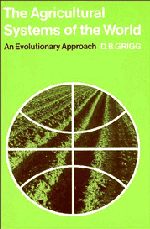Book contents
- Frontmatter
- Contents
- Acknowledgements
- 1 Introduction
- PART ONE
- PART TWO
- 5 Shifting agriculture
- 6 Wet-rice cultivation in Asia
- 7 Pastoral nomadism
- 8 Mediterranean agriculture
- 9 Mixed farming in western Europe and North America
- 10 Dairying
- 11 Plantations
- 12 Ranching
- 13 Large-scale grain production
- 14 Conclusions
- Appendix: Regions of plant domestication
- Notes
- Bibliography
- Index
- Frontmatter
- Contents
- Acknowledgements
- 1 Introduction
- PART ONE
- PART TWO
- 5 Shifting agriculture
- 6 Wet-rice cultivation in Asia
- 7 Pastoral nomadism
- 8 Mediterranean agriculture
- 9 Mixed farming in western Europe and North America
- 10 Dairying
- 11 Plantations
- 12 Ranching
- 13 Large-scale grain production
- 14 Conclusions
- Appendix: Regions of plant domestication
- Notes
- Bibliography
- Index
Summary
In most agricultural systems the same piece of land is cropped continuously, with occasional fallows. Frequently the fields are bounded by hedges, fences or ditches, and the agricultural landscape is ordered and permanent. In shifting agriculture this is not so. The farmer chooses a patch of forest, secondary or primary, cuts down some of the trees with an axe, leaving only the larger and economically useful, clears the undergrowth with a knife or cutlass, and burns the debris. Crops are sown on the clearing – or swidden – with a minimum of preparation, and receive only cursory attention during growth. After the first harvest crops are sown again for a further year or two, and then the land is left uncropped and colonisation by the natural vegetation is allowed whilst another patch of land is cleared for cultivation. Ideally the first clearing will not be used for crops again until it has been under a natural fallow for some years and soil fertility restored. Thus, the essential features of shifting cultivation are, first, the rotation of fields rather than crops, with short periods of cropping alternating with long periods of natural fallow; second, the use of slash-and-burn methods to clear the vegetation, and third, the maintenance of fertility by allowing the vegetation to regenerate.
Such a method of clearing land and maintaining soil fertility, although so different from the methods found in most of Europe, China and India, would hardly justify describing shifting agriculture as a farming system were it not that these features are invariably associated with other characteristics.
- Type
- Chapter
- Information
- The Agricultural Systems of the WorldAn Evolutionary Approach, pp. 57 - 74Publisher: Cambridge University PressPrint publication year: 1974



